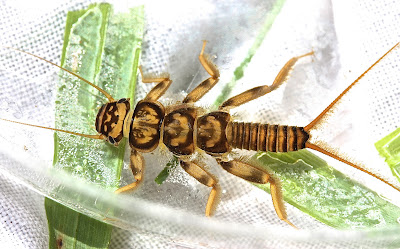Well, there was one difference: one of the common stoneflies I found was Acroneuria carolinensis -- at the Doyles I only saw Acroneuria abnormis. In case you've forgotten how we tell them apart, we have to look at the abdominal banding: on A. abnormis the anterior edge of each tergum is dark, the posterior light, with A. carolinensis, just the reverse is true. I'm partial to A. carolinensis.
The insects I found at the Lynch river this morning were essentially the same insects I found yesterday at the Doyles. I guess we should not be surprised: the two rivers are much the same size, and they flow through similar types of terrain, and they're both close to the Blue Ridge.
In any event -- lots of small brushlegged mayflies, lots of flatheaded mayflies, and a fair number of fingernet caddisfly larvae. And, again I found Clioperla clio Perlodids -- actually, I saw quite a few. Still not a whole lot of color, but these were a bit larger than those I found yesterday.
Now, how at this stage of the game, with a tiny, colorless insect, can we identify the species? It's not all that easy, and in the end, we have to use the microscope to look for key anatomical features. Still, the pattern that we see on the head -- faint though it might be -- is a pretty good clue for Clioperla clio. Here is a C. clio nymph that I found last year on 11/25.
Click on the photo so you can enlarge it. Note that I've pointed out three features that are characteristic of the C. clio head. 1) The large pale area in the center of the head is surrounded on all sides by a dark border: 2) The figure "M" anterior to the pale area is "exaggerated" -- i.e. the middle dips down deeply, almost in the form of a "U". And 3) -- and this is not used by entomologists as a key, just something that I've observed -- the space between the lateral ocelli, which are widely separated by the way, is dark.
Now look at the C. clio's that I found this morning. You can clearly make out all three of those features.
"Y" ridge:
lacinia:
As small as the nymphs were that I found yesterday and this morning, both of these features were clear.
Other photos:
1. Baetis pluto small minnow mayflies, male and female. (Different colors and different eyes.) I also saw smallish Baetis intercalaris nymphs -- but no Plauditus dubius.
2. And sure enough, a tiny small winter stonefly. (If you look closely, you can make out a wavy line forming at the back of the head.)
_______________
I'm eager to find some large winter stoneflies (Taeniopteryx), even though they're bound to be tiny. I think I have to head to Fluvanna county this week, where the water will be a bit warmer. We'll probably see them in that warmer water before we see them up here in the cold mountain streams.
______________
A glimpse of the Blue Ridge from Lynch River valley, early fall, 2012.











No comments:
Post a Comment